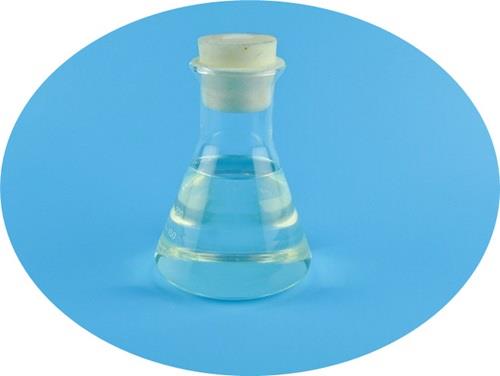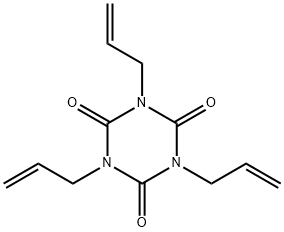Application Research of 1,3,5-tri-2-propenyl-1,3,5-triazine2,4,6(1H,3H,5H)-trione
Introduction
A crosslinking agent, 1,3,5-tri-2-propenyl-1,3,5-triazine-2,4,6(1H,3H,5H)-trione (TAIC;Triallyl isocyanurate; Figure 1), has been widely used in the preparation of polymers, and the polymers fabricated by TAIC have shown relatively better thermostability. TAIC is also one of the polyfunctional monomers with a thermally stable triazine ring and three allyl groups, which can make the microspheres possess a highly crosslinked structure and stability in the solvent, and a conducive to recovery.

Application study
1: Triallyl Isocyanurate as an Efficient Electrolyte Additive for Layered Oxide Cathode Material-Based Lithium-Ion Batteries
In this study, a new electrolyte additive 1,3,5-tri-2-propenyl-1,3,5-triazine-2,4,6(1H,3H,5H)-trione (TAIC) for lithium-ion batteries is reported. The additive is introduced as a novel electrolyte additive to enhance electrochemical performances of layered lithium nickel cobalt manganeseoxide (NCM) and lithium cobalt oxide (LiCoO2) cathodes, especially under a higher working voltage.Encouragingly, we found protective films would be formed on the cathode surface by the electrochemical oxidation, and the stability of the cathode material–electrolyte interface was greatly promoted.By adding 0.5 wt.% of 1,3,5-tri-2-propenyl-1,3,5-triazine-2,4,6(1H,3H,5H)-trione into the electrolyte, the battery exhibited outstanding performances. The thickness swelling decreased to about 6% after storage at 85 ◦C for 24 h, while the capacity retention of cycle-life performances under high temperature of 45 ◦C after the 600th cycle increased 10% in comparison with the batteries without TAIC. Due to its specific function, the additive can be used in high energy density and high voltage lithium-ion battery systems. This work may provide some useful references for the preparation of more stable LIBs due to the formation of high-quality CEI film in the battery.[1]
2: 1,3,5-tri-2-propenyl-1,3,5-triazine-2,4,6(1H,3H,5H)-trione–maleic anhydride copolymer for the removal of organic pollutants from water
Owing to the frequent occurrence of diclofenac sodium (DS) in fresh aquatic environments and its potential toxicity towards living organisms, the effective removal of DS has attracted worldwide attention. Herein, a green and efficient strategy to fabricate crosslinked microspheres with interconnected mesoporous structures and abundant adsorption active sites was developed. With this strategy, 1,3,5-tri-2-propenyl-1,3,5-triazine-2,4,6(1H,3H,5H)-trione (TAIC)-maleic anhydride (MAH) copolymer microspheres (TMs) with a diameter of 1.19-1.35 μm were first prepared by self-stabilized precipitation (2SP) polymerization, and the TMs possess a large amount reactive anhydride groups (62.5-71.8 mol%), a specific surface area of 51.6-182.4 m2/g and a mesoporous structure (average pore size: 3.4-3.8 nm). Then the TMs were further functionalized with polyethylenimine (PEI) to give rise to cationic microspheres (Cat-TMs), which showed excellent adsorption performance to DS with a rapid adsorption rate (reached equilibrium within 30 min), a very high equilibrium adsorption capacity (1421 mg/g) and excellent recyclability. The pseudo-second-order model and Langmuir model were a good fit for the adsorption kinetic and isotherm process, respectively. Furthermore, due to the high cation density (4.291 mmol/g) and excellent pH buffer capacity of Cat-TMs, the adsorption capacity can be maintained at a high level within the pH range of 6-10. The regenerated Cat-TMs showed only a slight loss (<5%) in the adsorption capacity even after 5 adsorption-desorption cycles. In short, Cat-TMs can be considered as a highly promising adsorbent for the rapid and ultra-efficient removal of anionic organic contaminants and have significant potential to be applied in wastewater treatment.[2]
3: Toughening of Biodegradable Poly(3-hydroxybutyrate-co-3-hydroxyvalerate)/Poly(ε-caprolactone) Blends
Reactive extrusion of poly(3-hydroxybutyrate-co-3-hydroxyvalerate)/poly(ε-caprolactone) (PHBV/PCL) blends was performed in the presence of cross-linker 1,3,5-tri-2-propenyl-1,3,5-triazine-2,4,6(1H,3H,5H)-trione (TAIC) and peroxide. The compatibility between the two biodegradable polymers was significantly improved only when TAIC and peroxide work together, as evidenced by the decreased PCL particle size and blurred interfacial gap between the PHBV and PCL. The mechanical, thermal, morphological, and rheological properties of the compatibilized blends were studied and compared to the blends without 1,3,5-tri-2-propenyl-1,3,5-triazine-2,4,6(1H,3H,5H)-trione and peroxide. At the optimal TAIC content (1 phr), the elongation at break of the compatibilized blends was 380% that of the PHBV/PCL blend without any additives and 700% that of neat PHBV. The improved interfacial compatibility, decreased PCL particle size, and uniform PHBV crystals are all factors that contribute to improving the toughness of the blend.The study shows that PHBV and PCL are cross-linked by 1,3,5-tri-2-propenyl-1,3,5-triazine-2,4,6(1H,3H,5H)-trione, resulting in the formation of a PHBV−PCL co-polymer, which improves the compatibility of the blend. The biodegradable polymer blends with high crystallinity and improved toughness prepared in this study are proposed to be used in sustainable packaging or other applications.
References
[1] Zhang CM, Li F, Zhu XQ, Yu JG. Triallyl Isocyanurate as an Efficient Electrolyte Additive for Layered Oxide Cathode Material-Based Lithium-Ion Batteries with Improved Stability under High-Voltage. Molecules. 2022;27(10):3107. Published 2022 May 12. doi:10.3390/molecules27103107
[2] Xu C, Shu H, Chen C, et al. Super-adsorbent microspheres based on a triallyl isocyanurate-maleic anhydride copolymer for the removal of organic pollutants from water. Nanoscale. 2023;15(8):4053-4062. Published 2023 Feb 23. doi:10.1039/d2nr07124j
[3] Zytner P, Wu F, Misra M, Mohanty AK. Toughening of Biodegradable Poly(3-hydroxybutyrate-co-3-hydroxyvalerate)/Poly(ε-caprolactone) Blends by In Situ Reactive Compatibilization. ACS Omega. 2020;5(25):14900-14910. Published 2020 Jun 16. doi:10.1021/acsomega.9b04379
You may like
See also
Lastest Price from 1,3,5-Tri-2-propenyl-1,3,5-triazine-2,4,6(1H,3H,5H)-trione manufacturers

US $10.00/KG2025-04-21
- CAS:
- 1025-15-6
- Min. Order:
- 1KG
- Purity:
- 99%
- Supply Ability:
- 100 mt

US $6.00/kg2025-04-21
- CAS:
- 1025-15-6
- Min. Order:
- 1kg
- Purity:
- 99%
- Supply Ability:
- 2000KG/Month


